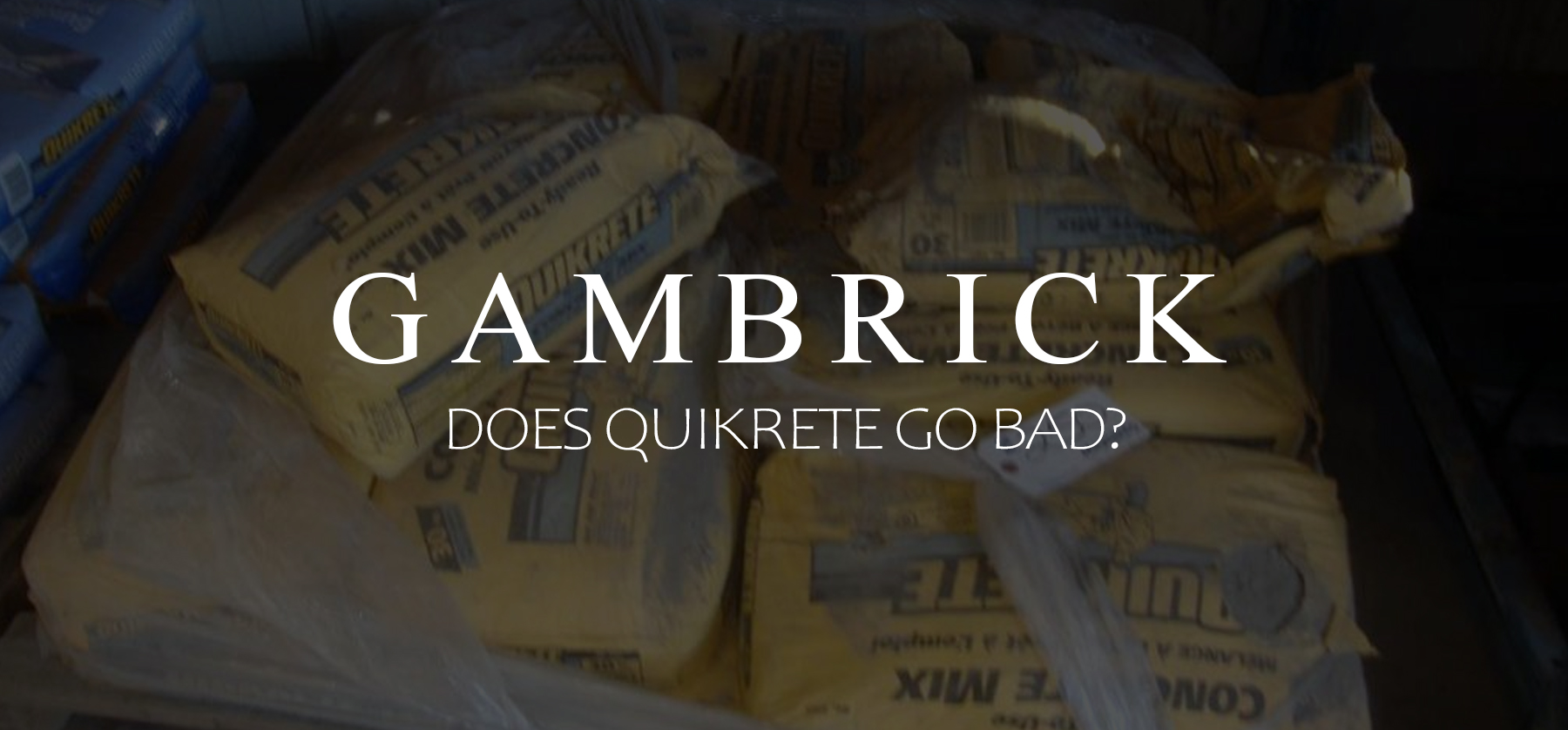Does Quikrete Go Bad?
Quikrete and other brands of bagged concrete are fantastic products for DIY enthusiasts and contractors alike. As a Home Builder, I routinely use bags of Quikrete on just about every job I do. Whether it be for filling a deck footing, setting a fence post, patching a sidewalk, or creating a custom concrete countertop. Quikrete bags really come in handy, so I always keep a few on every job. But does Quikrete go bad? What do you do with the bags that are left over? Can you store them safely for extended periods of time? These are all questions you need answered when working with Quikrete.
Quikrete is just like regular concrete, only it comes premixed and in a bag. The bag sizes typically range from 40 lbs to 80 lbs and come in a variety of specialty mixes like fast setting or crack resistant. When properly mixed with water, Quikrete is a strong, durable concrete that will last for decades. But because Quikrete comes in a variety of mixes, some varieties will set faster, with less shrinkage and more strength than regular concrete. This can be a big advantage if you need these attributes for your project.
Water activates and hardens Quikrete just like regular concrete. And just like regular concrete, Quikrete needs to be fresh to work properly. It’s unlikely to be as good if the dry mix is out of date because it does go bad. This is due to moisture getting into the bag and activating the cement without being properly mixed. When you open an old bag of Quikrete, you’ll notice lots of clumping. All those clumps are ruined concrete.
Ahead, we’ll talk more in-depth about how Quikrete goes bad and what you can do about it.
How Long Do Bags of Quikrete Last?
Quikrete eventually goes bad. But bags can generally be kept for 3-12 months, depending on how they’re stored. Although I’ve kept Quikrete bags for much longer by wrapping them tightly in plastic and keeping them in a very dry place.
The reason Quikrete goes bad is cement. When cement comes in contact with moisture, it chemically reacts and hardens. This is actually what makes concrete a great building material. However, it’s also a bad thing in terms of storage. If even a tiny amount of moisture gets into the bag, your cement will start to harden. How long it takes Quikrete to dry depends on several factors, such as water, temperature, and humidity.
When you open an old bag of Quikrete concrete, you may notice some clumping. This is the cement hardening due to moisture. Once this happens, the bag is ruined. The chemical reaction occurred too soon before the concrete had been properly mixed, and now the ratios are off.
Even if you break up the clumps and try to mix the concrete, it won’t be strong and probably won’t cure properly. The concrete will set soft and brittle. This is because the cement ratio is too low now that some of it has hardened prematurely.
Because of this, the strength of old Quikrete bags can deteriorate over time. Construction grade concrete that we use for foundations is always brand new. For some other non-structural applications, we may use older bags, but never anything that’s been compromised.
It’s estimated that bagged concrete loses 20% of its strength after 3 months and up to 40% after a year. That makes it way too weak for most applications.
For home DIY projects, this may be less important. Properly stored bags can be used for much longer, depending on the project.
Storing Quikrete Bags
If you want to store Quikrete it has to be done properly. If not, the bags will go bad faster than they should. Here’s a list of what I do to keep my bags dry and usable for as long as possible.
- Always store Quikrete above ground because moisture levels will generally be lower. Basements tend to be much damper.
- Place bags on a platform or pallet to keep them off the ground where moisture can collect.
- If you have a well ventilated room that’s a plus. Air helps keep things dry.
- Wrap the bags tightly in plastic. Ever notice how palettes of Quikrete are wrapped in plastic from the factory. There’s also an inner plastic lining. Both are meant to keep moisture out of the bag.
How To Know If Quikrete Has Gone Bad
Checking a Quikrete concrete bag to see if it’s still good is pretty easy. Cut it open and feel through the mix with a trowel. You can do it with your hand too but I’d wear some gloves. If the mix is dry and clumped in places that means moisture got in.Any clumping at all of the cement is a clear sign of moisture.
Once moisture has gotten to the cement the concrete is no good for structural work. It’ll be weak and brittle because the ingredient ratios are off. Cement is a very important part of making strong and durable concrete. If some has been ruined by moisture the mix won’t cure properly. But that doesn’t mean it’s all trash. There are still DIY applications for old Quikrete.
Concrete vs. Quikrete
Concrete is one of the most widely used building material in the world. It’s made up of cement, fine and coarse aggregates, and water. Cement is the active ingredient that binds all the other materials together. If you’ve ever mixed Quikrete you’ll notice that it gets sticky like a paste. That’s the cement and water. When cement is mixed with water it causes hydration which is the hardening and strengthening of concrete. Sand and stone aggregate give concrete it’s high strength but don’t bind it together.
The most commonly used cement for concrete is Portland cement. It’s a fine powder that’s typically made from limestone and clay or shale. Although it may also include a few other materials like shells, chalk, slate, and iron ore. The ingredients are heated at extremely high temperatures in a kiln and then ground into a powder. This powder is called cement.
Concrete is a great product because it’s fairly cheap, easy to make and readily available all over the world. And it’s easy to form into whatever shape you pour it into. This makes it a great material to build bridges, homes, sidewalks and even huge structures like damns out of.
Quikrete offers a rapid set concrete in additional to it’s standard mixes. Rapid set is made similarly to concrete, only it’s formulated to hydrate much quicker than a standard mix. They achieve this by including calcium sulfoaluminate (CSA), a compound that triggers a faster reaction between the minerals and water. This fast setting feature, in addition to other special features, are what gives Quikrete an advantage in many situations.
I can’t tell you how many times a fast setting bag of Quikrete has helped me on a job. However, fast setting Quikrete can go bad faster than regular mixes.
Uses of CSA Quikrete Concrete
Regular concrete shrinks as it dries which can result in cracking. However, because CSA concrete sets so quickly, it is less likely to crack. This can be a huge advantage in fine applications like concrete countertops or cast products.
Quikrete fast setting mixes gain strength very quickly. This allows it to be used on projects that are time sensitive. It’s also generally stronger than Portland cement and has a lower carbon footprint because of less carbon dioxide emissions during the manufacturing process.
Quikrete is easy to mix and easy to lay. But it does set quickly so make sure your ready to go once it’s mixed. It will typically set in less than an hour.
Quikrete fast setting mixes do go bad easier than regular mixes because of how quickly they react with moisture. When moisture gets into a bag of concrete it reacts with the cement which ruins the mix. This is true of any bagged concrete. However, with fast setting mixes this happens faster. Even a small amount of moisture can harden the concrete.
How Long Does Mixed Quikrete Last Before It Goes Bad?
Once dry Quikrete is mixed with water it sets up in the same amount of time as regular concrete. However, the fast setting mix is much quicker. Don’t mix a batch of fast set until your ready to go. Quikrete fast set concrete will start to set in around 20 to 40 minutes, so it’s important to work quickly. However, this can be affected by outside temperatures. You only have about an hour before it’s completely hard which means it’s gone bad. There’s no way to undo the process and pour hardened concrete.
It’s important to make sure your Quikrete is properly mixed before you pour it. Too much or too little water will both effect the strength of the finished concrete which is another way it can go bad. Quikrete generally requires one part water to every five parts dry mix. Follow the instructions on the bag carefully. What you want is a consistency like thick oatmeal. If it’s like soup then you’ve added too much water. If you still see dry mix then you haven’t added enough.
When it’s cold outside, below 32°F, then I’d recommend waiting to pour. Concrete that’s poured in the cold can freeze as it cures which ruins the mix. Frozen concrete can actually turns brittle like a powder which ruins the entire project.
If it is very hot, above 90°F, then you also need to be careful. Quikrete needs time to properly cure and reach full strength. When it’s extremely hot, water can evaporate too quickly which weakens and cracks the concrete.
As you can see, there are quite a few ways Quikrete can go bad. The most common is from moisture but it can also be ruined due to improper installation.
The Durability of Finished Quikrete Concrete
Quikrete is an incredibly durable and long lasting product. It’s naturally resistant to the elements and very strong. When properly mixed, some concrete mixes can support over 5000 pounds per square inch. That makes it a very good product for structural applications. Especially when reinforcements are added like rebar and wire mesh. In general, concrete or Quikrete structures can easily last 50 to 100 years. Many are demolished long before the concrete has gone bad.
Concrete can withstand factors that are damaging to other materials. Things like weather, vermin, temperature extremes, most chemicals, impacts, abrasion, heavy weight and sea water. This is why most large scale structures like bridges, buildings and damns use lots of concrete.
For huge projects, Quikrete isn’t typically used because they mix large amounts of concrete in trucks. But for smaller applications bagged concrete is a great product. It’s just as durable as regular concrete and lasts just as long.
Final Thoughts
Quikrete is a wonderful product that has all sorts of uses. The quick setting mix really comes in handy when your in a time crunch. I almost always have a bag or two on every job site just in case we need it. And we usually do.
What’s important to know about Quikrete, and all other concrete products, is that it needs to be stored correctly. If moisture gets into the bag then it’s ruined.
Once mixed, Quikrete should be used immediately to ensure it doesn’t harden before the job is done. This is especially true of the fast setting mix.
Summary: Does Quikrete Go Bad?
Quikrete, and other brands of bagged concrete, are a fantastic product for DIY enthusiasts and contractors alike. As a Home Builder, I routinely use bagged concrete on just about every job I do. Whether it be for filling a deck footing, setting a fence post, patching a sidewalk or creating a custom concrete countertop. Quikrete bags really come in handy so I always keep a few on every job. But does Quikrete go bad? What do you do with the bags that are left over? Can you store them safely for extended periods of time? These are all questions you need answered when working with Quikrete.
Quikrete is just like regular concrete only it comes premixed and in a bag. The bag sizes typically range from 40 lbs to 80 lbs and come in a variety of specialty mixes like fast setting or crack resistant. When properly mixed with water, Quikrete is a strong, durable concrete that will last for decades. But because Quikrete comes in a variety of mixes, some varieties will set faster, with less shrinkage and more strength than regular concrete. This can be a big advantage if you need these attributes on your project.
Water activates and hardens Quikrete just like regular concrete. And just like regular concrete, Quikrete needs to be fresh to work properly. It’s unlikely to be as good if the dry mix is out of date because it does go bad. This is due to moisture getting into the bag and activating the cement without being properly mixed. When you open an old bag of Quikrete you’ll notice lots of clumping. All those clumps are ruined concrete.
If you have any questions or comments about Quikrete E-mail any time.





















